The Audi Q5 is a remarkable choice in the luxury compact SUV market. It blends elegant aesthetics, cutting-edge technology, and exceptional road performance. This vehicle’s performance is greatly enhanced by its advanced suspension system, which ensures a comfortable and steady ride no matter the driving conditions.
The Audi Q5’s suspension plays a crucial role in its design, impacting various aspects such as handling and comfort. It is built on the versatile MLB platform, which it shares with other models like the Audi A4 and A5.
Understanding the Audi Q5’s suspension system well allows owners to understand the engineering behind their vehicle better and enables them to recognize and resolve any common issues.
Come along as we explore the intricate world of Audi Q5 suspension, uncovering its crucial role in delivering the exceptional driving experience synonymous with the Audi brand.
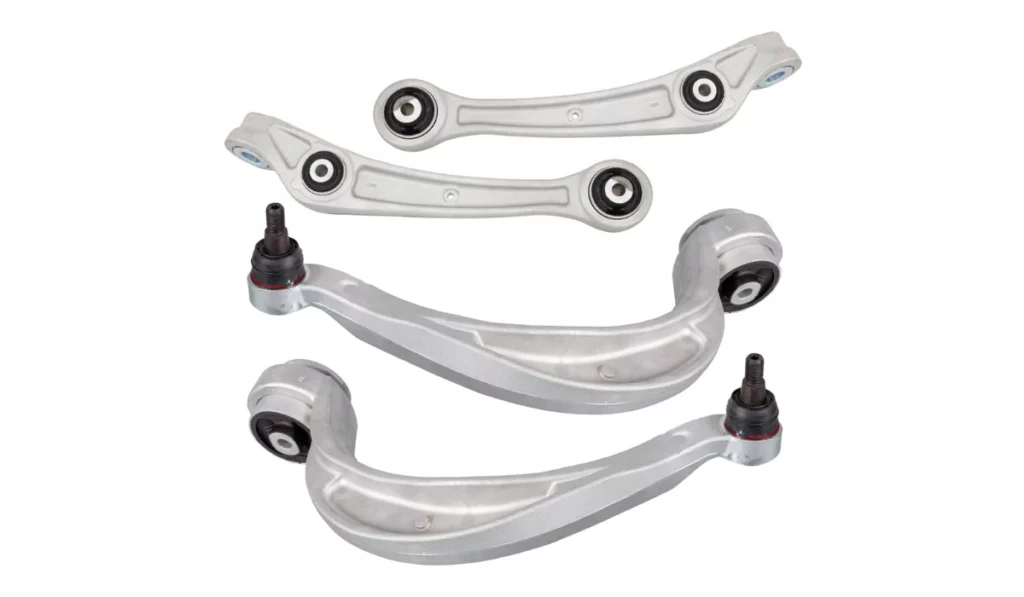
Understanding the Audi Q5 Suspension System
The Modular Longitudinal Matrix (MLB) platform is a cornerstone of Audi’s engineering, underpinning not only the Audi Q5 but also its cousins, the Audi A4 and A5, and other vehicles from the broader Volkswagen Group family, including the Porsche Macan and Bentley Bentayga.
The MLB is designed to accommodate longitudinal engine configurations, providing a versatile foundation supporting various drivetrains, including front-wheel drive, all-wheel drive, and hybrid setups. The MLB platform ensures that vehicles like the Audi Q5 balance performance and utility.
By sharing this platform with high-performance and luxury models such as the Macan and Bentayga, the Audi Q5 benefits from a chassis capable of handling powerful engines and advanced drivetrains while maintaining the structural integrity and precision expected in premium SUVs.
Engineering for Comfort and Stability
The Audi Q5 has a sophisticated suspension system designed to optimize comfort and stability. It uses a multi-link suspension setup at both the front and rear. This multi-link suspension allows for precise wheel alignment adjustments, which is crucial for maintaining stability at high speeds and during cornering. Each wheel can move independently, greatly reducing the transfer of road imperfections to the cabin and enhancing ride quality.
The role of the suspension system in a vehicle like the Audi Q5 cannot be overstated. It is integral for providing a comfortable ride that mitigates bumps and shocks and maintains vehicle stability. A well-tuned suspension helps keep the vehicle level stable, irrespective of the road conditions. This is particularly important for SUVs like the Audi Q5, which may be used on varying road surfaces, from urban highways to rural paths.
Furthermore, the Audi Q5’s advanced suspension setup contributes to its safety and handling characteristics, ensuring that steering responses are sharp and predictable. By maintaining optimal contact between the tires and the road surface, the suspension system helps enhance the vehicle’s braking performance and overall agility, making it a pleasure to drive under various conditions.
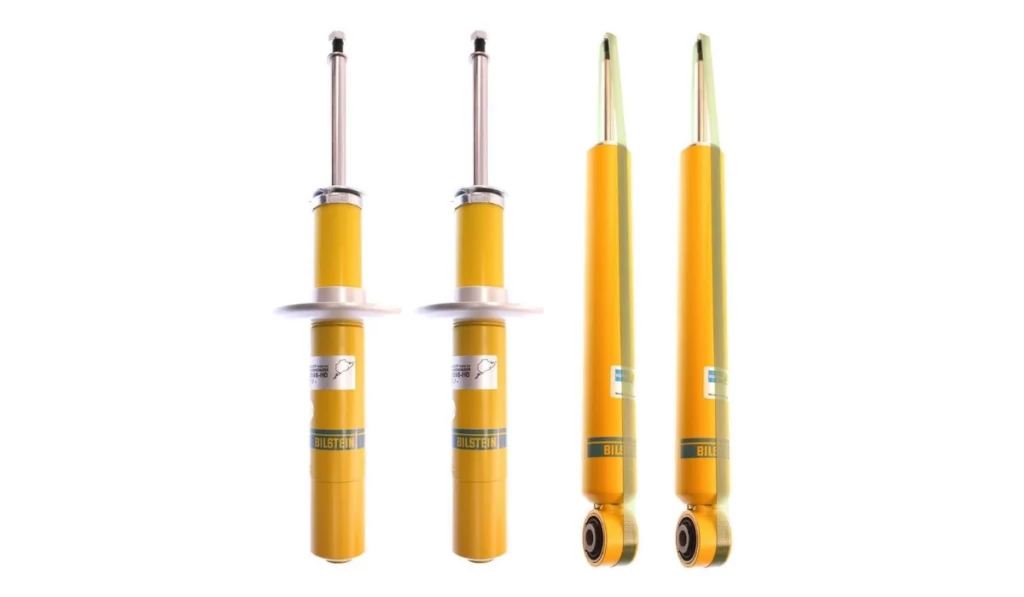
Common Suspension Problems in the Audi Q5
While the Audi Q5 is lauded for its high vehicle stability and comfort, characteristic of German engineering excellence, this complexity also means that various suspension components are prone to wear and failure over time. Understanding these common issues can help owners identify early signs of trouble and address them before they escalate into costly repairs.
Front Suspension Issues
The front suspension of the Audi Q5 is equipped with multiple links that provide excellent handling characteristics. However, the complexity of this system means more points of potential wear and failure. Owners may notice issues such as reduced ride quality, unusual noises during turns or over bumps, and even decreased handling precision as the vehicle ages.
Upper and Lower Control Arms
Each wheel on the Audi Q5 is guided by two sets of control arms: upper and lower. These arms are crucial for aligning the wheels and absorbing road shock. Unfortunately, they can wear out due to mechanical stress, leading to suspension noises, uneven tire wear, and potential handling issues. Regular inspections are recommended to check for any play or deterioration in these components.
Lower Ball Joints
One failure point in the Audi Q5’s suspension system involves the lower ball joints, particularly the lower ball joint of the forward lower control arm. Failure of these can result in a clunking noise and excessive vibration that can be felt even on the steering wheel, significantly impacting the vehicle’s safety and handling.
Shock Absorbers
Shock absorbers on all sides of the Audi Q5 can fail, leading to a less controlled and uncomfortable ride. Symptoms of worn shock absorbers include increased bouncing, swaying during wind gusts, and the vehicle dipping forward when braking. Replacing shock absorbers with signs of leakage or failure is critical in maintaining the vehicle’s performance and comfort.
Front Stabilizer Links
The stabilizer links in the Audi Q5 help reduce body roll during turns. These links are stressed when maneuvering and can become loose or damaged, resulting in rattling noises during low-speed maneuvers and reduced cornering stability.
Air Springs
The air springs or bellows are susceptible to leaks and failures, particularly in Audi Q5 models equipped with air suspensions. These issues can lead to sagging ride height, poor handling, and uneven tire wear. Regular inspection for air leaks or a noticeable decrease in suspension performance is crucial, especially in older or high-mileage vehicles.
Do stabilizer links affect alignment?
No, stabilizer links do not affect wheel alignment. Stabilizer links, or sway bar links, are integral components of a vehicle’s suspension system that connect the sway bar to the suspension to reduce body roll during turns. They help maintain vehicle stability and control by distributing the weight and force more evenly across the chassis when the vehicle turns.
Although crucial for handling, they do not directly influence the alignment of the wheels. However, worn or damaged stabilizer links can lead to poor handling and uneven tire wear, indirectly affecting the overall driving experience.
Want to know more about your car’s wheel alignment? Our detailed article “Intro to Wheel Alignment” already covers this. Look it up to learn more!
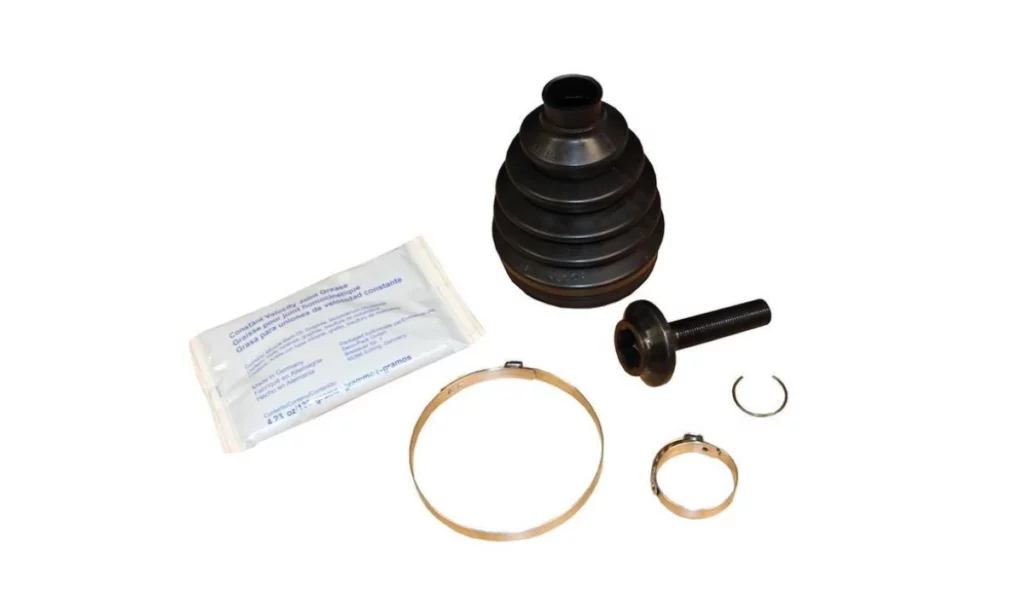
Constant Velocity (CV) Joints and Boots
CV joints and their protective boots are essential for smoothly transferring power from the engine to the wheels, especially when turning the vehicle. If not addressed promptly, the boots can become cracked or damaged, leading to grease leakage and eventual CV joint failure.
Symptoms of a failing CV joint may include clicking noises when turning or vibrations during acceleration. Checking the condition of the CV boots regularly can prevent more significant issues.
Rear Suspension Durability
Contrary to the front suspension, the Audi Q5’s rear suspension is noted for its durability and has fewer recorded issues. This relative robustness means less frequent maintenance concerns from the rear, but regular checks are still advisable to ensure overall vehicle integrity.
Secure Fantastic Deals on Genuine VW/Audi Parts
Join us at eEuroparts.com, where we provide an extensive selection of genuine Audi and original equipment manufacturer (OEM) parts at unmatched costs online.
By providing every Audi fan with high-quality suspension parts, we hope to eliminate the need for expensive maintenance and fulfill our objective accordingly. Our extensive catalog is painstakingly compiled to meet the specific requirements of your Audi Q5, ensuring a perfect fit and strict conformance to Audi’s standards.
With eEuroparts.com, you can save significant cash without compromising the quality of the components you purchase. This makes us the go-to option for Audi do-it-yourself fans who value unrivaled and unshakable quality.
Maintenance Tips and Remedies
Maintaining the suspension of your Audi Q5 is crucial to ensure its longevity and optimal performance. Regular inspections and timely maintenance can prevent the worsening of minor issues into costly repairs.
Routine Inspection and Maintenance Schedules
It’s advisable to thoroughly inspect the Audi Q5’s suspension system for signs of wear every 50,000 miles. However, some components, like the front upper control arms, may require attention sooner, as they can develop surface cracks as early as 20,000 miles.
Is it OK to replace only one control arm?
Replacing just one control arm on your Audi Q5 is generally not recommended. Replacing both control arms simultaneously ensures balanced performance and handling, as these components wear at similar rates. Doing so maintains the vehicle’s stability, optimizes the alignment, and extends tire life.
Since a wheel alignment is necessary after replacing a control arm, addressing both simultaneously is more cost-effective. Alignments can be expensive, and replacing both arms prevents the need for a second alignment soon when the other arm potentially fails.
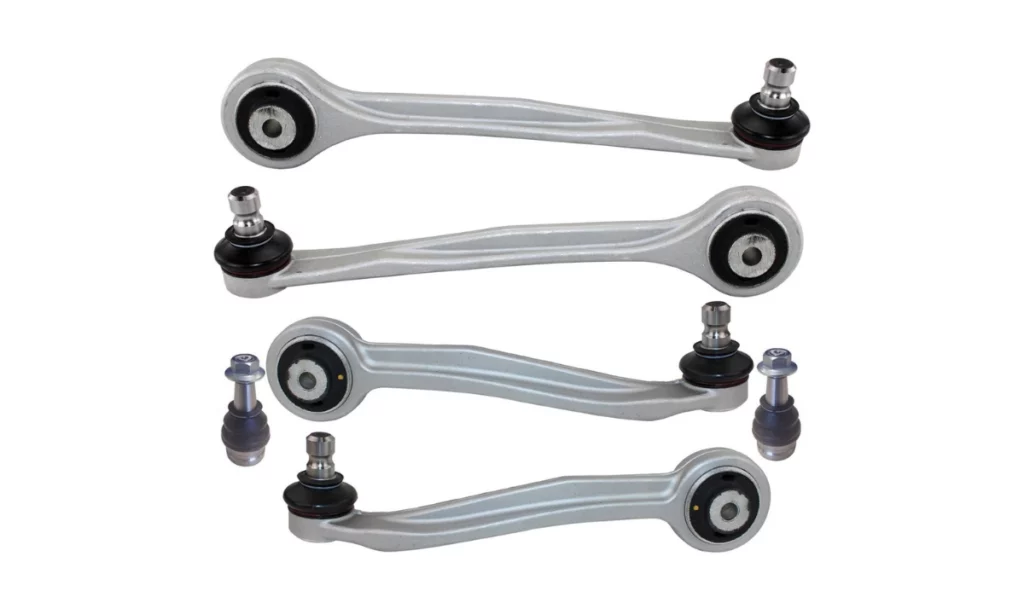
This proactive approach saves time and money in the long run, reducing the frequency of maintenance appointments and ensuring consistent driving quality.
Checking for Common Suspension Issues While you Drive
Specific noises and sensations while driving can alert you to potential problems requiring attention. This section will guide you through the essential checks you can perform while driving, helping you identify issues such as loose components, worn-out bushings, or alignment problems before they become more severe and costly to repair.
Listen for Noises
When driving your Audi Q5, the sounds it makes can tell you a lot about the health of your suspension. Here’s how to effectively listen for potential problems:
Drive Over Various Surfaces — To test the suspension, drive over different speeds and road surfaces, such as bumps, potholes, and uneven roads. Listen carefully for clunking, rattling, or squeaking noises.
Clunking Noises — These often occur when there are worn-out bushings, damaged ball joints, or loose suspension components. A clunking sound when going over bumps or making turns can specifically indicate that control arms or stabilizer links need attention.
Rattling Noises — These can be caused by smaller components that have become loose or damaged, such as tie rods or hardware connected to the shock absorbers or struts.
Turn and Brake — Listen while turning at low speeds in parking lots or when braking suddenly. Noise during these maneuvers can highlight issues with the shock absorbers or springs that might not be apparent at higher speeds.
Feel the Ride
The handling and stability of your Audi Q5 are direct indicators of suspension integrity. Here’s what to feel for:
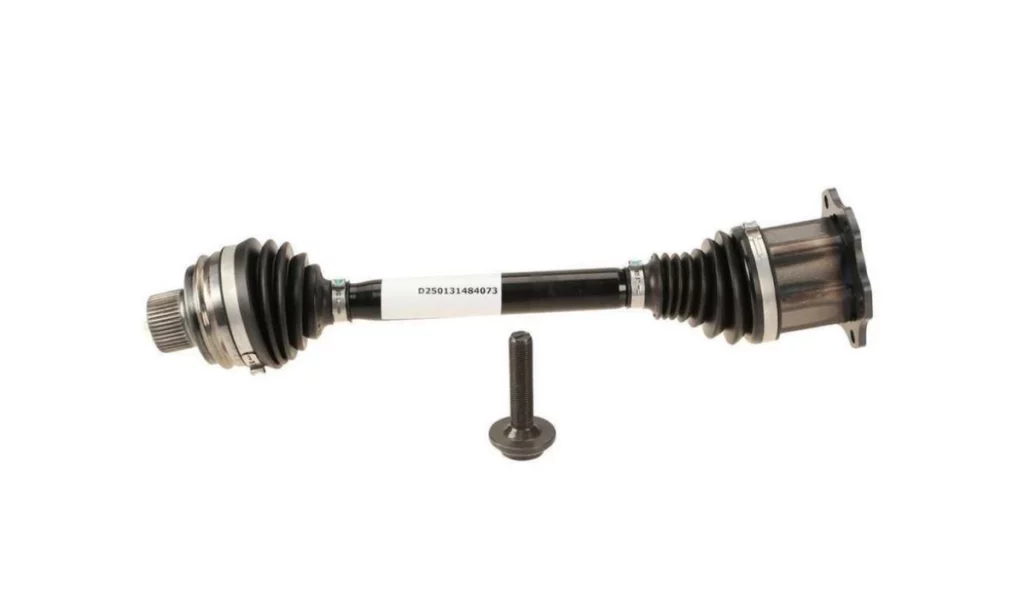
Handling and Stability — Take note of how the car behaves during turns. If the car feels unstable or wobbly, it may suggest problems with the suspension springs or dampers.
Car Pulling to One Side — This usually points to alignment issues but can also suggest uneven wear or damage to suspension parts. It’s important to check for uneven tire wear, which can amplify this problem.
Excessive Bouncing — After going over bumps, if your vehicle continues to bounce or feels floaty, it could indicate worn shock absorbers or struts. Properly functioning shocks should stabilize the car quickly after a bump.
Vibrations — Unusual vibrations during your drive can be due to unbalanced wheels, but they can also point to deeper issues in the suspension system, like failing ball joints or bushings.
By combining these auditory and physical checks while driving, you can get a clearer picture of the condition of your Audi Q5’s suspension system. Regular attention to these details can help catch issues early, preventing more significant problems and potential safety hazards.
Step-by-Step Guide to Simple Suspension Checks at Home
After your test drive indicates possible suspension issues in your Audi Q5, it’s essential to identify which components might be causing these problems. Conducting a thorough inspection at home allows you to pinpoint specific issues and plan ahead of time.
This systematic guide provides detailed steps to perform effective checks on your vehicle’s suspension system, covering everything from bushings and ball joints to shock absorbers and CV joints. Following these steps in your garage or driveway ensures your Audi Q5 remains in optimal driving condition.
Step 1: Park on a Level Surface
Start by parking your vehicle on a flat surface to ensure accurate inspection results. This positioning is crucial for checking the shock absorber function accurately.
Step 2: Check Shock Absorber Function
Press down firmly on each vehicle corner to test the shock absorbers. Observe how the car bounces back. If it bounces repeatedly, this may indicate worn shock absorbers needing further inspection or replacement.
Step 3: Prepare the Vehicle for Undercarriage Inspection
Ensure the system is switched off for vehicles with air suspensions before lifting. This prevents calibration issues or potential damage. Use a hydraulic jack to raise the car and securely support it with jack stands to safely inspect the suspension components underneath.
Step 4: Inspect Shock Absorbers for Leaks
Examine each shock absorber for signs of fluid leaks. Fluid on the exterior of the shock absorber usually signifies a failure, necessitating replacement to maintain optimal performance and safety.
Step 5: Check CV Joint Boots for Leaks
Inspect the CV joint boots for tears or grease leaks. Grease marks on the outside of the boot indicate a tear, which can lead to CV joint failure if not addressed promptly.
Step 6: Examine Bushings on Control Arms and Stabilizer Links
Use a flashlight to check for cracked or deteriorating rubber bushings on all control arms and stabilizer links. Employ a pry bar to gently apply pressure and stretch the bushings, making hidden cracks visible. Worn bushings can affect ride quality and handling and require replacement.
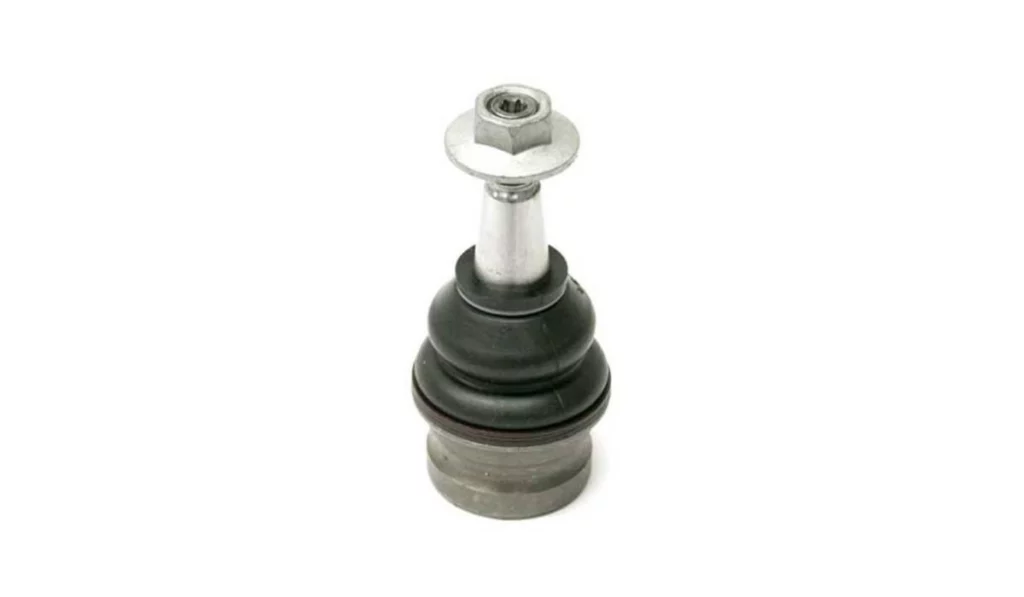
Step 7: Test Ball Joints for Play
Utilize a pry bar to apply upward and downward pressure on the ball joints to test for any play or excessive movement. Significant play in the ball joints indicates wear and the need for service or replacement to ensure proper wheel alignment and prevent tire wear.
Step 8: Reactivate Air Suspension and Overnight Test
Lower the vehicle and reactivate the air suspension system if equipped. After turning the air suspension back on, park the car overnight. Check the next morning to see if the suspension has significantly lowered. A noticeable drop could indicate a leak or defect in the air suspension system that requires professional attention.
Tips to Prolong Audi Q5’s Suspension Components
Maintaining the suspension system of your Audi Q5 not only enhances the vehicle’s performance but also extends the lifespan of its components. Follow these practical tips to ensure your suspension remains in excellent condition:
Regular Inspections
Incorporate suspension checks into your routine vehicle maintenance schedule. Inspecting the suspension system annually, ideally during oil change appointments is advisable. Regular inspections help catch issues early, reducing the risk of major repairs.
Maintain Proper Tire Pressure
It is crucial to keep tires inflated to the manufacturer-recommended pressure. Proper tire pressure ensures even tire wear, better fuel efficiency, and optimal contact with the road, alleviating unnecessary stress on the suspension system.
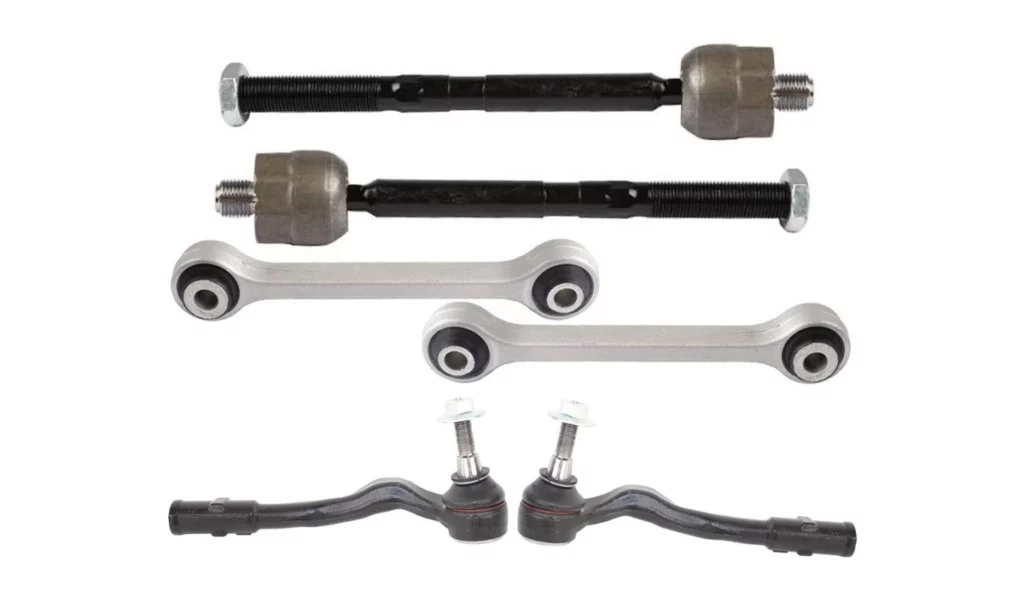
Avoid Oversized/Undersized Wheels and Spacers
While aftermarket wheels can enhance your vehicle’s appearance, choosing wheels that match the original size and offset specifications is vital. Oversized or undersized wheels can significantly affect the suspension geometry and put additional strain on the drivetrain and suspension components, leading to premature wear.
Avoid Potholes and Rough Roads
If you drive carefully to avoid bumps and rough road surfaces, you can prevent your suspension parts from getting damaged. Your wheels, struts, and springs can get bent or broken when you hit a bump. Choose routes with better surfaces when you can, and be careful when driving in places where the roads aren’t in good shape.
Timely Replacement of Worn Components
Proactively replacing worn or damaged suspension parts is essential for maintaining the vehicle’s handling and safety. Worn components, such as bushings, springs, and dampers, compromise the suspension system’s effectiveness and can lead to other related problems. Address these issues promptly to ensure a comfortable and safe driving experience.
eEuroparts.com: Your Solution to Audi Q5 Suspension Issues
For Audi Q5 owners facing suspension problems, eEuroparts.com offers a reliable solution with an extensive inventory of high-quality parts. Whether you need shock absorbers, control arms, ball joints, or stabilizer links, our parts meet or exceed OEM specifications, ensuring your vehicle maintains its superior ride quality and stability.
eEuroparts.com provides competitive pricing and expert support to help you find the right parts quickly and efficiently. With easy navigation and secure shopping, eEuroparts.com enhances your maintenance experience by making it straightforward to get the parts you need at reasonable prices. Choose eEuroparts.com for dependable, quality solutions for all your Audi Q5 suspension needs.












